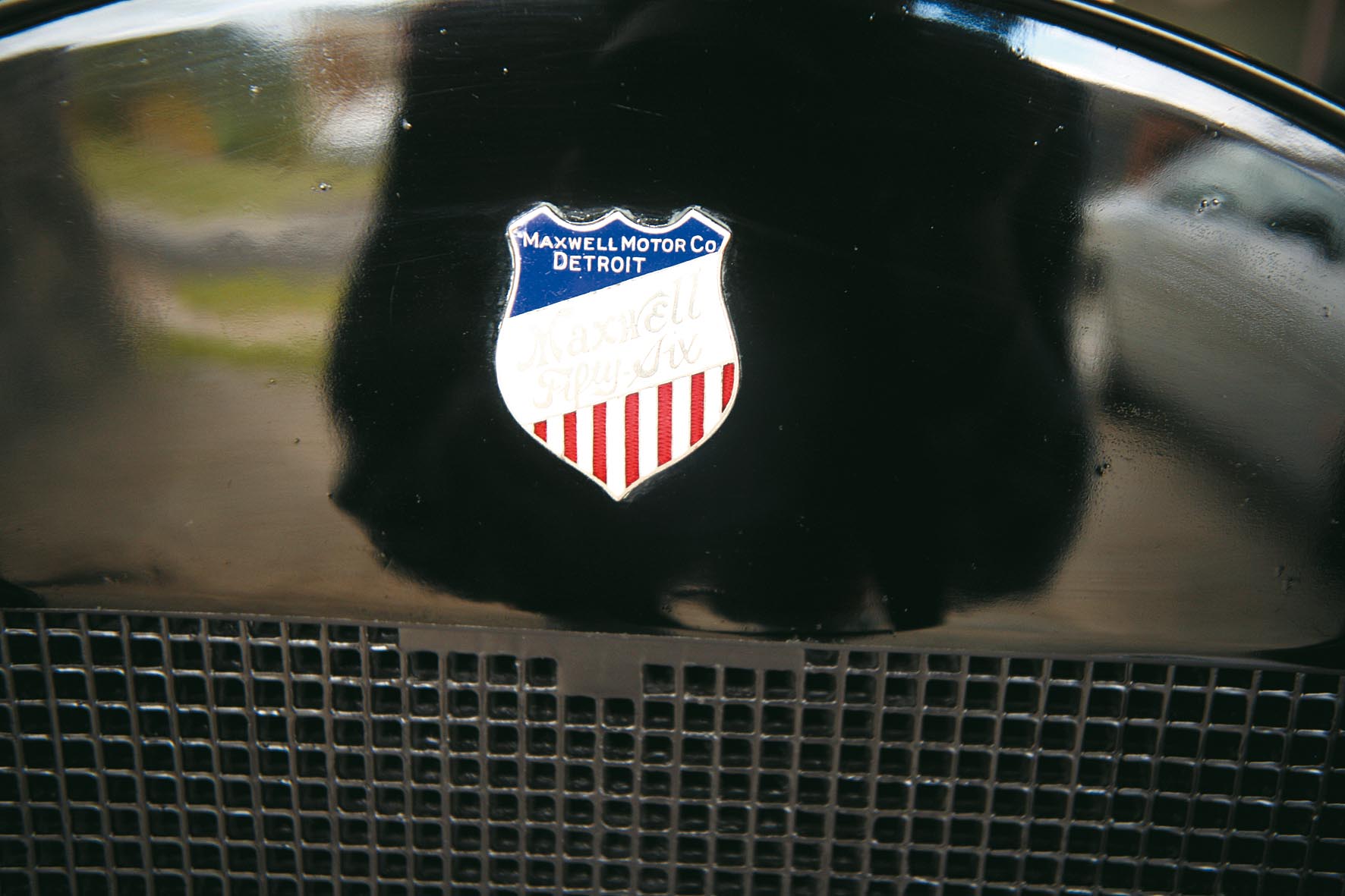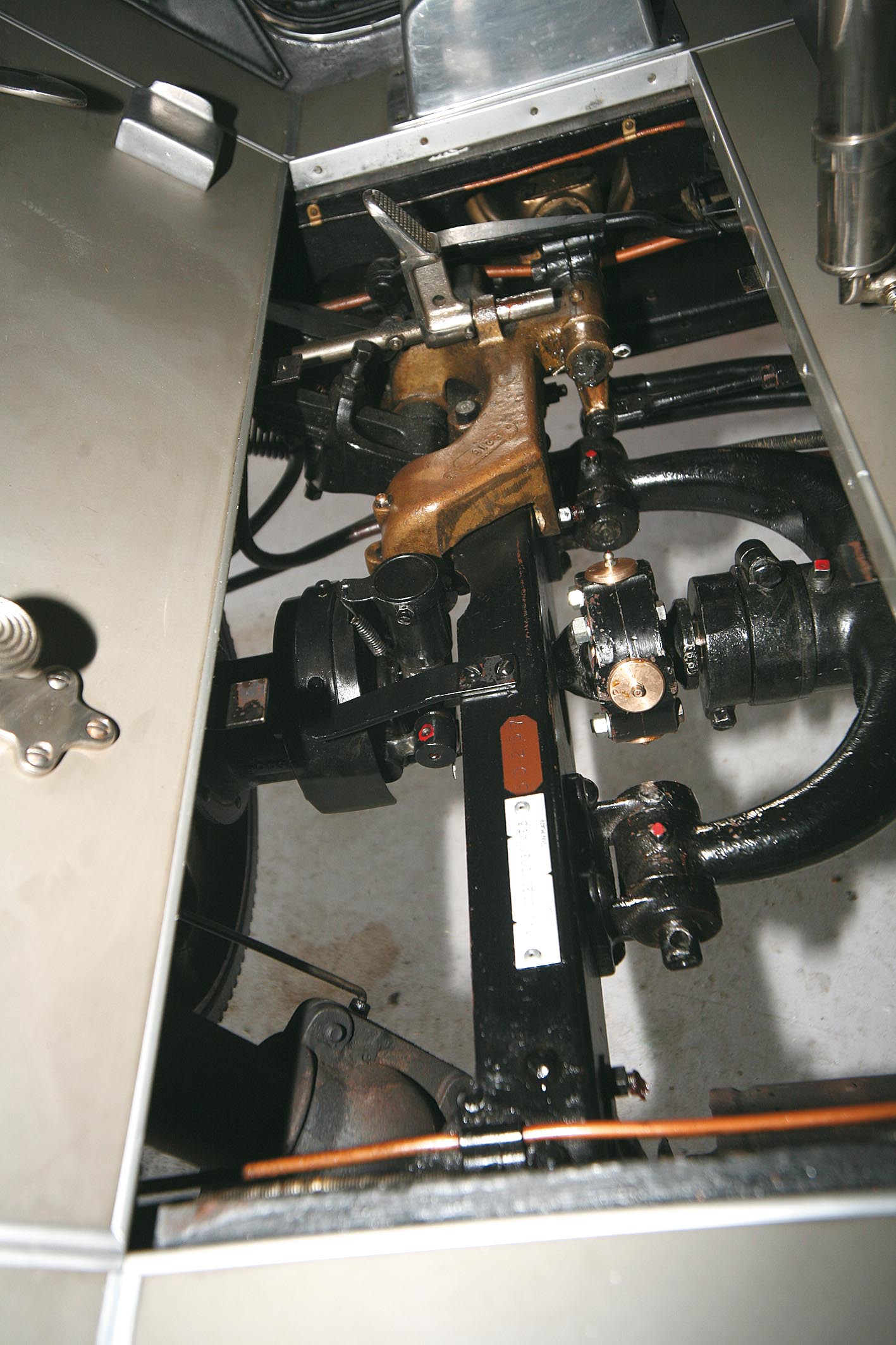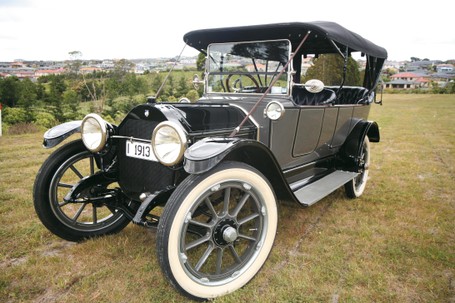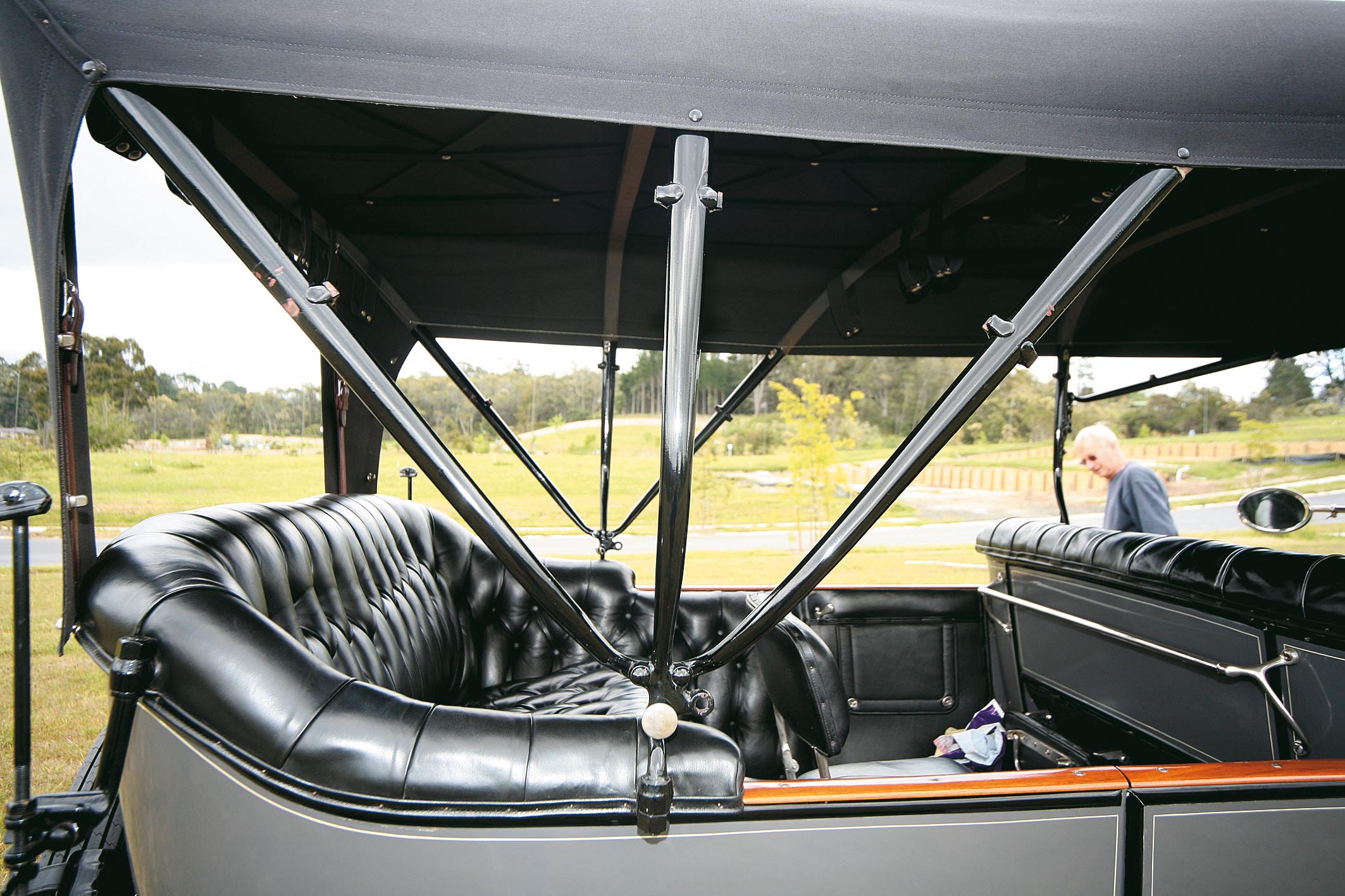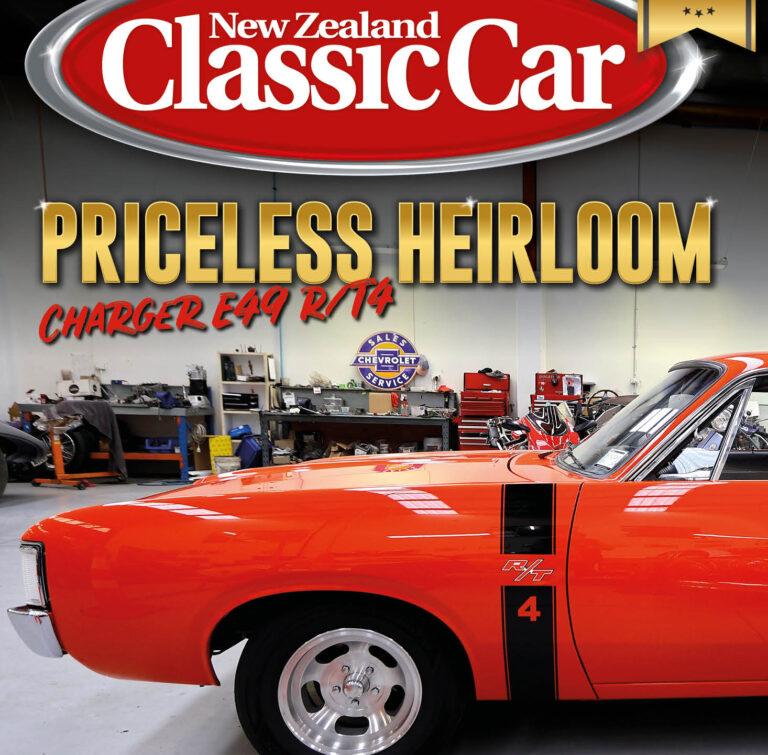data-animation-override>
“Published in New Zealand Classic Car Issue No. 206”

Penn checks out a surprisingly useable antique car, considering it is very nearly a century old
Bob Ballentyne is so steeped in collectible cars that he’s long since ceased being easily impressed. Indeed, rather like any hot-blooded man at a beauty contest, he’s in love with every example indiscriminately. Nevertheless, Bob expressed all kinds of awe when he described Kit Maxwell’s new toy to me — an enormous example of 1913 horseless carriage, a milestone on the evolutionary progress from horse-drawn cart to 2008 Ferrari.
To me it’s a milestone because, when you examine the mechanicals (including its big gutsy motor), there are so many indicators of the future. Indicators that also show how much progress has been made in a very few years.
I was continually impressed by the car’s finish and the attention to detail. Every aspect has been designed and engineered in a manner typical of the attention to quality so characteristic of those early years of the 20th Century.
“I don’t think the original car can have been used much, The pedals aren’t worn, the side curtains are original and in excellent order, but most significantly the mechanicals are very tight.” Kit’s thankful about the starter motor that Maxwell fitted.
The three-speed gearbox is mounted just forward of the back axle, fed by a torque tube and in turn connected by a very short driveshaft — for a short time I thought that I was looking at a transaxle, like an Alfetta GTV.
Solid old girl
Despite wood-spoked wheels and split rims the car is surprisingly easy to push because the metre-diameter wheels have a very small footprint — the Maxwell’s 36-inch by 4.5-inch tyres have a very small contact on the ground. Then consider that brakes are fitted only to the rear, with the handbrake and foot brake (one contracting and one expanding) sharing the same brake drum. You soon realise that thinking ahead is a good way to drive this solid old girl, which weighs 1500kg.
Power comes from a physically huge motor; 6.0 litres of monobloc with the exhaust manifold cast into the block. It’s in excellent order and complete with a water pump, choke and a summer start-up system — the updraught carburettor is water jacketted and feeds between the cylinders, so the mixture is preheated as it enters the manifold. There’s also a generator controlled by a clutch that prevents overcharging. The car is well thought out, showing how far American designers had progressed.
Walter E Flanders, Maxwell’s founder, designed and engineered this car. However, not many of these sixes were built. By far the greatest number of Maxwells — well over 100,000 — were four-cylinder cars. As a result, our featured Maxwell is rare; one of only two known survivors.
It’s an original and complete car, professionally restored in 1980 in the USA where it won first prize at a national show, and was then put in a museum and never used.
Through the internet, Kit discovered the museum was selling off its collection and, having a weakness for horseless carriages, he left an absentee bid (well below published expectations) after arranging from someone to check the vehicle. At the time the US dollar was weak and this made a huge difference to the final price, with Kit’s bid eventually securing the Maxwell.
What really impressed me was the perfection of the whole vehicle, it looks like new old stock in every facet; not like a ‘restored’ car. Indeed, there are so many interesting features to this car that I’ve not been able to do it justice, simply for lack of space.
On the road
These old girls are a very different experience. You sit high up, well above almost everything else on the road. This sensation is accentuated paradoxically by the smooth surface of modern roads, which compensates for the reality of the Maxwell’s unsophisticated suspension. The car seems to progress on rails until you come to a corner, when the cart springs give you a roll this way then that way. You become very conscious that you have returned to the dawn of motoring. The three-to-one ratio and the metre-diameter wheels give this car very long legs. This passenger felt under-employed, but the driver is happy because he’s busy with foot and hand brake, non synchro three-speed ’box and a choice of hand throttle or foot accelerator, so he hasn’t time for nervous reflection.
However, Kit has several of these sorts of cars, knows what he’s doing and does it for pleasure. He takes no notice of nervous old buggers like me.
That said, the Maxwell is classically American — big, strong and well-made, with loads of unsubtle torque propelling you along the road at whatever speed is allowed. You know that if a modern got in the way the Maxwell would make short work of it.
On the firewall the cabling is beautifully laid out, and the plug leads are all secured to a wooden dock that prevents cross-firing and keeps the leads firmly in place.
Instead of a petrol pump you pressurise the tank with a hand pump beside the driver, and then a small valve on the camshaft maintains that pressure in service.
The instruments include a very inaccurate speedometer, an oil gauge showing the oil flow, an ammeter, the petrol tank pressure, a lights switch and a large main ignition switch. There’s also an exhaust cut-out pedal that gives a satisfying bellow when opened.This is a very satisfyingly and useable antique — a truly vintage car.
Various ancestors
From the beginning, Americans were hugely enthusiastic about horseless carriages, so there was a proliferation of makers offering them. The USA is a major continent offering extremes of roading, urbanisation and climate. Additionally, its citizens seemed to have a willingness to relocate on the drop of a hat, so this new form of personalised transport came at just the right time.
By 1913 more than a decade of experience had seen a surge of development in the engineering involved. Although the Europeans, especially the Germans and the French, were the inventors and developers of the horseless carriage, it was the Americans who adopted the idea with huge enthusiasm and got into serious production and, consequently, serious selling.
Europe was at a very different stage of civilisation and people were not nearly so mobile; the horse and cart was still the vehicle of choice amongst the hairy masses and, of course, there was that matter of disposable income.
Major figures such as Ford, Chrysler, Hudson, Packard and Studebaker are known worldwide, and they are but a few of the brilliant men who founded and drove the American automobile colossus.
Walter E Flanders is less well-known. Born in 1871 in Rutland, Flanders was the son of a country doctor. At the age of 15 he left school to pursue a career in the mechanical trades. He worked with sewing machines during an apprenticeship at Singer, then worked at general machining with Thomas S Walburn in Cleveland.
It was here that
an order came from Henry Ford for a thousand crankshafts. The order was not only filled, but filled on time — a rarity in those days. This convinced Ford that Flanders was just the man to have on the team he was assembling to move his company into quantity manufacture of automobiles.
Flanders was a very big man and a genius at factory organisation. He was also a great partying man, something which grated on the rather joyless Ford, so eventually Flanders went off as part of EMF (he was the F). Later still he owned the lot and built Maxwells. It’s quite a story. Americans of those days were very interesting characters, especially compared to the present crop.
In 1911, the top five automobile manufacturers and their production figures were:
1. Ford, 69,762
2. Studebaker-EMF, 26,827
3. Willys-Overland, 18,745
4. Maxwell, 16,000
5. Buick, 13,389
Maxwell was a significant player, which makes the low survival rate very surprising.
In 1923 Maxwell became Chrysler, and it was only in recent decades that the original Maxwell factory used by Chrysler for many years was shut down.
Words & Photos: Penn McKay

